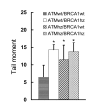Hemizygosity for Atm and Brca1 influence the balance between cell transformation and apoptosis
- PMID: 20175908
- PMCID: PMC2834696
- DOI: 10.1186/1748-717X-5-15
Hemizygosity for Atm and Brca1 influence the balance between cell transformation and apoptosis
Abstract
Background: In recent years data from both mouse models and human tumors suggest that loss of one allele of genes involved in DNA repair pathways may play a central role in genomic instability and carcinogenesis. Additionally several examples in mouse models confirmed that loss of one allele of two functionally related genes may have an additive effect on tumor development. To understand some of the mechanisms involved, we examined the role of monoallelic loss or Atm and Brca1 on cell transformation and apoptosis induced by radiation.
Methods: Cell transformation and apoptosis were measured in mouse embryo fibroblasts (MEF) and thymocytes respectively. Combinations of wild type and hemizygous genotypes for ATM and BRCA1 were tested in various comparisons.
Results: Haploinsufficiency of either ATM or BRCA1 resulted in an increase in the incidence of radiation-induced transformation of MEF and a corresponding decrease in the proportion of thymocytes dying an apoptotic death, compared with cells from wild-type animals. Combined haploinsufficiency for both genes resulted in an even larger effect on apoptosis.
Conclusions: Under stress, the efficiency and capacity for DNA repair mediated by the ATM/BRCA1 cell signalling network depends on the expression levels of both proteins.
Figures



Similar articles
-
Combined haploinsufficiency for ATM and RAD9 as a factor in cell transformation, apoptosis, and DNA lesion repair dynamics.Cancer Res. 2005 Feb 1;65(3):933-8. Cancer Res. 2005. PMID: 15705893
-
Mechanisms of increased risk of tumorigenesis in Atm and Brca1 double heterozygosity.Radiat Oncol. 2011 Aug 17;6:96. doi: 10.1186/1748-717X-6-96. Radiat Oncol. 2011. PMID: 21849032 Free PMC article.
-
Differing effects of breast cancer 1, early onset (BRCA1) and ataxia-telangiectasia mutated (ATM) mutations on cellular responses to ionizing radiation.Int J Radiat Biol. 2003 Oct;79(10):817-29. doi: 10.1080/09553000310001610952. Int J Radiat Biol. 2003. PMID: 14630541
-
Ataxia-telangiectasia mutated kinase (ATM) as a central regulator of radiation-induced DNA damage response.Acta Medica (Hradec Kralove). 2010;53(1):13-7. doi: 10.14712/18059694.2016.57. Acta Medica (Hradec Kralove). 2010. PMID: 20608227 Review.
-
Ataxia-telangiectasia mutated and the Mre11-Rad50-NBS1 complex: promising targets for radiosensitization.Acta Med Okayama. 2012;66(2):83-92. doi: 10.18926/AMO/48258. Acta Med Okayama. 2012. PMID: 22525466 Review.
Cited by
-
NRF2 Mediates Cellular Resistance to Transformation, Radiation, and Inflammation in Mice.Antioxidants (Basel). 2022 Aug 25;11(9):1649. doi: 10.3390/antiox11091649. Antioxidants (Basel). 2022. PMID: 36139722 Free PMC article.
-
Double Heterozygous Mutations in the BRCA2 and ATM Genes: A Case Report and Review of the Literature.Breast Care (Basel). 2021 Aug;16(4):412-417. doi: 10.1159/000511430. Epub 2020 Oct 29. Breast Care (Basel). 2021. PMID: 34602949 Free PMC article.
-
FLASH Radiotherapy: Benefits, Mechanisms, and Obstacles to Its Clinical Application.Int J Mol Sci. 2024 Nov 21;25(23):12506. doi: 10.3390/ijms252312506. Int J Mol Sci. 2024. PMID: 39684218 Free PMC article. Review.
-
Double heterozygous pathogenic variants prevalence in a cohort of patients with hereditary breast cancer.Front Oncol. 2022 Aug 8;12:873395. doi: 10.3389/fonc.2022.873395. eCollection 2022. Front Oncol. 2022. PMID: 36003761 Free PMC article.
-
Multi-locus inherited neoplasia alleles syndromes in cancer: implications for clinical practice.Eur J Hum Genet. 2025 Mar;33(3):289-296. doi: 10.1038/s41431-025-01785-1. Epub 2025 Jan 23. Eur J Hum Genet. 2025. PMID: 39843919 Free PMC article.
References
-
- Bartek J, Lukas J, Bartkova J. DNA damage response as an anti-cancer barrier: damage threshold and the concept of 'conditional haploinsufficiency'. Cell Cycle. 2007;6:2344–2347. - PubMed
-
- Santarosa M, Ashworth A. Haploinsufficiency for tumour suppressor genes: when you don't need to go all the way. Biochim Biophys Acta. 2004;1654:105–122. - PubMed
Publication types
MeSH terms
Substances
LinkOut - more resources
Full Text Sources
Research Materials
Miscellaneous

